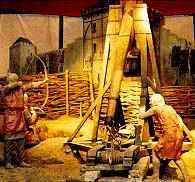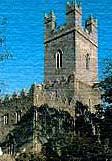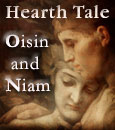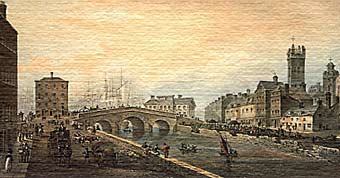


King John
Sovereign of England
From 1199 to 1216
John was the youngest son of King Henry II and Queen Eleanor of Aquitane.
The conflict and betrayal which marked this family would be reflected
on into John's own reign.
When John was only eighteen, Henry II sent him to Ireland to represent
the crown and learn the duties of rulership. John proved ill suited for
the task and not only worsened the relationship with the Irish but created
troubles with English landholders as well.
Within less than a year John returned to England, his efforts in Ireland
a disaster.

Ireland
Introduction
Ireland
Contents

eirelore@elore.com
|
|
Limerick, Ireland
 King
John's Castle lies at the very heart of Limerick's medieval core,
the old English town on The King's Island, just north of Limerick's City
center. Today, an extended riverside section of English town is known
as the Heritage Precinct, and is undergoing major restoration, becoming,
once again, the administrative and visitor center of the city. King
John's Castle lies at the very heart of Limerick's medieval core,
the old English town on The King's Island, just north of Limerick's City
center. Today, an extended riverside section of English town is known
as the Heritage Precinct, and is undergoing major restoration, becoming,
once again, the administrative and visitor center of the city.
The Welcoming Shannon
 Limerick
City is magnificently sited on one of Europe's finest rivers, the
Lordly Shannon, here where the soft bog and fresh water meet the salt
of the sea. Today, it is difficult to picture the 9th century scenes,
when fleets of Viking vessels sailed upriver to plunder and terrorize
the Monastic Midlands. In later centuries these Norsemen settled and founded
the trading port of Limerick. Limerick
City is magnificently sited on one of Europe's finest rivers, the
Lordly Shannon, here where the soft bog and fresh water meet the salt
of the sea. Today, it is difficult to picture the 9th century scenes,
when fleets of Viking vessels sailed upriver to plunder and terrorize
the Monastic Midlands. In later centuries these Norsemen settled and founded
the trading port of Limerick.
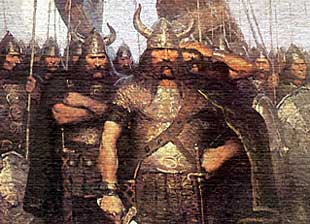
A nineteenth century romantic depiction
of Viking warriors.
 King
John's Castle was built to defend the river frontier between the Gaelic
west and Norman Leinster and Munster. This was the original Thomond bridge.
Today, at Limerick, three bridges span the winding river, as it spreads
itself towards the Atlantic Ocean. King
John's Castle was built to defend the river frontier between the Gaelic
west and Norman Leinster and Munster. This was the original Thomond bridge.
Today, at Limerick, three bridges span the winding river, as it spreads
itself towards the Atlantic Ocean.
 The
River Shannon and King John's Castle live side by side, a little above
the Curraghour Falls, at Thomond Bridge. This majestic river, the longest
in Ireland or Britain opens its tidal waters to welcome the international
fleets of the world, just as it has done for the mariners of countless
years. The
River Shannon and King John's Castle live side by side, a little above
the Curraghour Falls, at Thomond Bridge. This majestic river, the longest
in Ireland or Britain opens its tidal waters to welcome the international
fleets of the world, just as it has done for the mariners of countless
years.
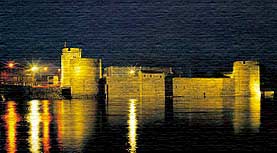
King John's Castle at Evening
Guarding the Shannon
 Many
have sailed on its hospitable waves from the sea inland to the very
heart of Ireland, very often pausing awhile on the now walled banks of
this wondrous city of Limerick. In the past, King John's Castle acted
as a watchdog on these sailors and their diverse cargoes, both human and
otherwise. But, today, it can throw caution to the wind, and warmly welcome
all. Many
have sailed on its hospitable waves from the sea inland to the very
heart of Ireland, very often pausing awhile on the now walled banks of
this wondrous city of Limerick. In the past, King John's Castle acted
as a watchdog on these sailors and their diverse cargoes, both human and
otherwise. But, today, it can throw caution to the wind, and warmly welcome
all.
 The
King's Island, approximately 80 hectares in extent, created by a loop of the River
Shannon, locally called the Abbey River, is connected to the city mainland by four
bridges: Thomond, Matthew, Baal and O'Dwyer. Sited, as this island is, at the lowest
fording point of the River Shannon above the estuary, its strategic location attracted
Viking colonies from the 9th century on. Then the O'Briens, Kings of Thomond, held
sway, endowing St. Mary's Cathedral in the late 12th century. Subsequent Anglo-Norman
occupation fortified the fledgling city, erecting King John's Castle as its administrative
center, and walling what became known as English town. The
King's Island, approximately 80 hectares in extent, created by a loop of the River
Shannon, locally called the Abbey River, is connected to the city mainland by four
bridges: Thomond, Matthew, Baal and O'Dwyer. Sited, as this island is, at the lowest
fording point of the River Shannon above the estuary, its strategic location attracted
Viking colonies from the 9th century on. Then the O'Briens, Kings of Thomond, held
sway, endowing St. Mary's Cathedral in the late 12th century. Subsequent Anglo-Norman
occupation fortified the fledgling city, erecting King John's Castle as its administrative
center, and walling what became known as English town.
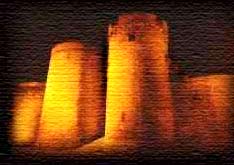
The gate towers of King John's castle.
|











